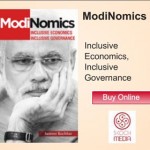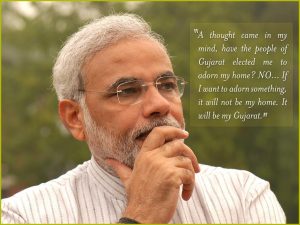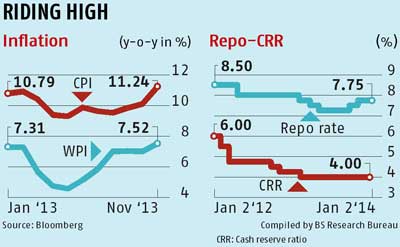 Modinomics will boost growth
Modinomics will boost growth
The book Modinomics – Inclusive Economics, Inclusive Governance authored by Sameer Kocchar talks about Narendra Modi’s thought process and his idealism on the Indian Economy. Mr. Modi feels that neither Soviet style socialist path nor free-market western capitalist economy is going to work for India. He is of the view that the country must have a unique blend of its own socio-economic policies that would leverage India’s unique strengths and propel it further to centre-state economy. Modi also feels that India’s unique strengths – its diverse demography, geography, and natural resources are not utilized so far. Modinomics is about inclusive economics and inclusive governance. The book highlights the uniqueness of the brand Narendra Modi – who is very Swadeshi at heart, while also globalist and pragmatist. He is bureaucratic, always thinks big, while he pays attention to details. A Gujarati to the core and believes in India first.
 The book talks about Modi’s rise which has overlapped with the UPA II Government’s downfall due to the economic slowdown. Modi’s intelligence and pragmatism helped him captured the political and economic mind space left vacant by the UPA. Modi’s Gujrat model has stood tall on two things one is his is personal vision and ambition for the state and second is his ability to get the best out of the bureaucracy by delegating it authority and responsibility. Modi’s hawk- eyed administration kept the state administration tick round the clock. His astute communication allowed him to rise; he is blessed with oratory skills. He used social media to the fullest by subtle messaging and a natural wit. He is the most followed leader on social media and his website is interactive. Kocchar has written the book precisely in a chronological order.
The book talks about Modi’s rise which has overlapped with the UPA II Government’s downfall due to the economic slowdown. Modi’s intelligence and pragmatism helped him captured the political and economic mind space left vacant by the UPA. Modi’s Gujrat model has stood tall on two things one is his is personal vision and ambition for the state and second is his ability to get the best out of the bureaucracy by delegating it authority and responsibility. Modi’s hawk- eyed administration kept the state administration tick round the clock. His astute communication allowed him to rise; he is blessed with oratory skills. He used social media to the fullest by subtle messaging and a natural wit. He is the most followed leader on social media and his website is interactive. Kocchar has written the book precisely in a chronological order.
Modi’s charisma got the Bharatiya Janata Party (BJP) and its allies the whooping 336 seats in the 2014 Loksabha election. No sooner he came to power, he sent a loud message to corporate houses and investors—both nationally and internationally, that India is open for business again. His mantra “maximum governance, minimum government” says a lot about his liberalization instinct and opening of the economy further by reducing hindrance. He is well aware of the left centered intellectual mainstream in the nation; which will initially create some roadblocks for him to push forward major economic reforms. Modinomics centers on lower government debt, more privatization and greater openness to foreign investors.
 India’s economy is stumbling under high inflation and the worst slowdown since free-market reforms in the early 1990s, and the budget is the first major test of Mr Modi’s reformist credentials since he swept to power in May with a pledge to boost growth and create millions of new jobs. In its first ever budget, the new government has promised a new era of fiscal prudence and greater opportunities for foreign investors in key sectors of the economy, what is worth praises is defense is given priority which was overdue. To ensure that the military, which has repeatedly used warned of outdated and inadequate equipment, has its way on the modernization drive, the government has budgeted Rs. 94,588 crores, Rs. 5000 crore more than what was sanctioned by the previous government in February in the interim budget this year. Overall defense spending has gone up by Rs. 26,000 crores.
India’s economy is stumbling under high inflation and the worst slowdown since free-market reforms in the early 1990s, and the budget is the first major test of Mr Modi’s reformist credentials since he swept to power in May with a pledge to boost growth and create millions of new jobs. In its first ever budget, the new government has promised a new era of fiscal prudence and greater opportunities for foreign investors in key sectors of the economy, what is worth praises is defense is given priority which was overdue. To ensure that the military, which has repeatedly used warned of outdated and inadequate equipment, has its way on the modernization drive, the government has budgeted Rs. 94,588 crores, Rs. 5000 crore more than what was sanctioned by the previous government in February in the interim budget this year. Overall defense spending has gone up by Rs. 26,000 crores.
The budget promotes skilling and vocational training among youth and to make them job-ready. The stress is laid on rural entrepreneurship; to encourage rural youth to start their own ventures, Finance Minister. Jaitley has announced a spending of Rs 100 crore to start village entrepreneurship training schemes. Recognizing the importance of stepping up vocational trainings and bringing it at par with the higher education system, he has announced the ‘Skill India’ programme and allocated an amount of Rs 14,389 crore for job creation, a huge part of which will hopefully be spent in training the youth.
 The Finance Minister has also proposed setting up of five new Indian Institutes of Technology (IITs) and five Indian Institutes of Management (IIMs) across the country at a cost of Rs 500 crore, this shows the new government’s inclination and keenness to accelerate the skills of youth, education is given priority. For the farmers, the budget has announced a slew of much-awaited measures. Focus on increasing irrigation facilities, farm markets, financial help to landless farmers and Kisan TV to provide real time information to farmers would help in increasing productivity of the farm sector. Moreover, Haryana, Jharkhand will have research centers in Horticulture, Agriculture and Maharashtra will get agri-biotech clusters.
The Finance Minister has also proposed setting up of five new Indian Institutes of Technology (IITs) and five Indian Institutes of Management (IIMs) across the country at a cost of Rs 500 crore, this shows the new government’s inclination and keenness to accelerate the skills of youth, education is given priority. For the farmers, the budget has announced a slew of much-awaited measures. Focus on increasing irrigation facilities, farm markets, financial help to landless farmers and Kisan TV to provide real time information to farmers would help in increasing productivity of the farm sector. Moreover, Haryana, Jharkhand will have research centers in Horticulture, Agriculture and Maharashtra will get agri-biotech clusters.
The budget is has tried to touch the aspirations of all sections of society. Landless farmers will be given cheaper credit, the rural poor have been promised broadband, cheaper TVs and better roads, Dalit-focused schemes have been allocated more money, the middle class have been given tax breaks and India’s holiest river will get funds for a clean-up.
 To give a stimulus to the infrastructure and manufacturing sector, a 10-year tax holiday for undertakings that generate and transmit power has been unveiled. Focus on industrial infrastructure such as a plan to establish seven industrial cities in India would enhance industrialization and create employment opportunities in the economy. The allocation for urban infrastructure earmarked at Rs 50,000 crore is really appreciable and this would expedite the pace and urbanization in the country and give a massive boost to growth and expand the national economy much faster.
To give a stimulus to the infrastructure and manufacturing sector, a 10-year tax holiday for undertakings that generate and transmit power has been unveiled. Focus on industrial infrastructure such as a plan to establish seven industrial cities in India would enhance industrialization and create employment opportunities in the economy. The allocation for urban infrastructure earmarked at Rs 50,000 crore is really appreciable and this would expedite the pace and urbanization in the country and give a massive boost to growth and expand the national economy much faster.
 The boost to Real Estate Investment Trusts (REITS) and Infrastructure Investment Trusts is very encouraging news for the real estate and infrastructure markets as it offers innovative and modern tools of investment to Indians. These are all important signals. Investment allowance of 15% to the manufacturing companies investing Rs 25 crore in plant and machinery would accelerate capital investments and propel manufacturing growth.
The boost to Real Estate Investment Trusts (REITS) and Infrastructure Investment Trusts is very encouraging news for the real estate and infrastructure markets as it offers innovative and modern tools of investment to Indians. These are all important signals. Investment allowance of 15% to the manufacturing companies investing Rs 25 crore in plant and machinery would accelerate capital investments and propel manufacturing growth.
 Steps are undertaken to revive SEZs would help to rejuvenate the investment cycle. Similarly, facilitation to manufacturing units to sell their products through retail and e-commerce would reduce the selling cost and benefit both manufacturers and consumers. Furthermore, it is also a taxpayer-friendly budget as the income-tax exemption limit has been raised by Rs 50,000 to Rs 2,50,000, the PPF ceiling to Rs 1,50,000, housing loan rebate to Rs 2,00,000, investments under 80C to Rs 1,50,00. In view of this, through appropriate tax planning those drawing a salary up to Rs 6,00,000 can bring down their tax liability to nil.
Steps are undertaken to revive SEZs would help to rejuvenate the investment cycle. Similarly, facilitation to manufacturing units to sell their products through retail and e-commerce would reduce the selling cost and benefit both manufacturers and consumers. Furthermore, it is also a taxpayer-friendly budget as the income-tax exemption limit has been raised by Rs 50,000 to Rs 2,50,000, the PPF ceiling to Rs 1,50,000, housing loan rebate to Rs 2,00,000, investments under 80C to Rs 1,50,00. In view of this, through appropriate tax planning those drawing a salary up to Rs 6,00,000 can bring down their tax liability to nil.
Taking into account the fact that our Finance Minister got only 45 days’ time to prioritize his priorities and for drawing up the budget for 2014-15, he has done an excellent job because this budget is undoubtedly very progressive, astute and realistic. Modi has consolidated ministries and scrapped cabinet panels to streamline administration  and speed decisions. Finance Minister, Jaitley has been honest about not being interested in “mindless populism” in burdening public finances.
and speed decisions. Finance Minister, Jaitley has been honest about not being interested in “mindless populism” in burdening public finances.
I personally think Modinomics is put into practice in the Union Budget – 2014 in inclusive economics and inclusive governance.












































